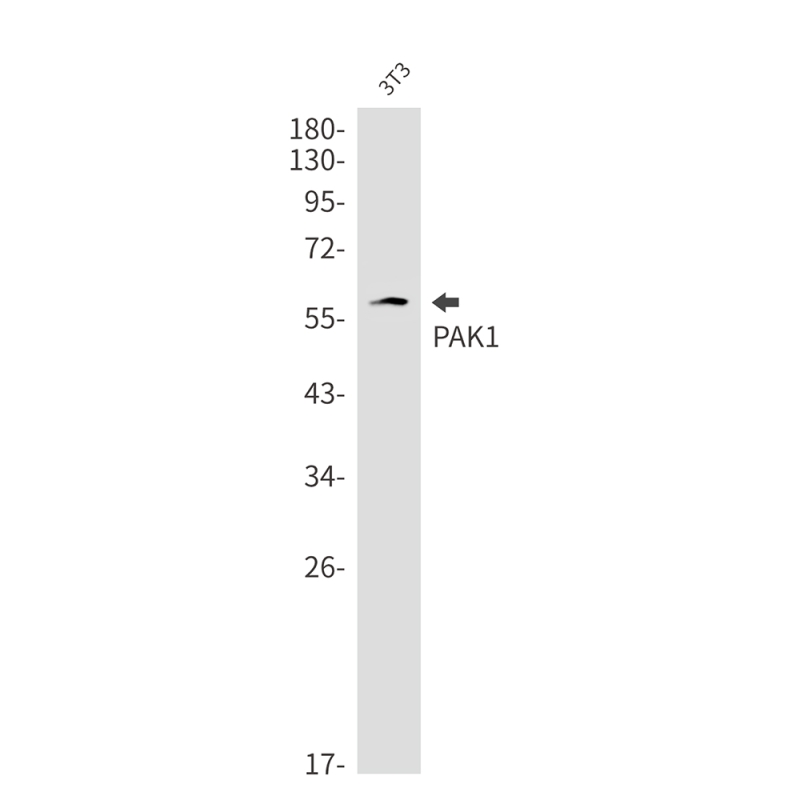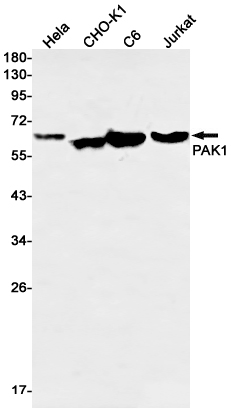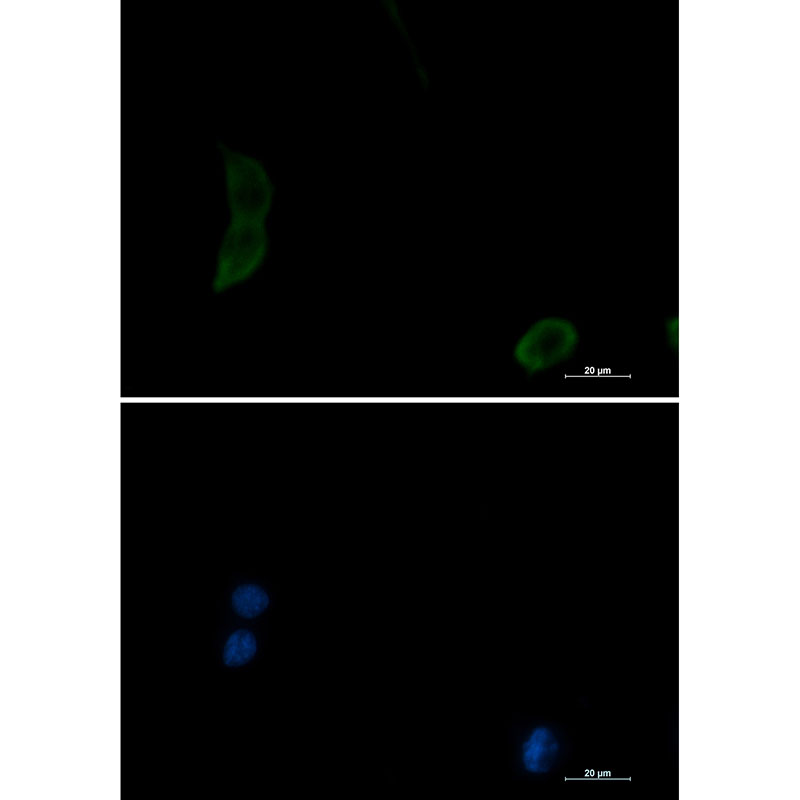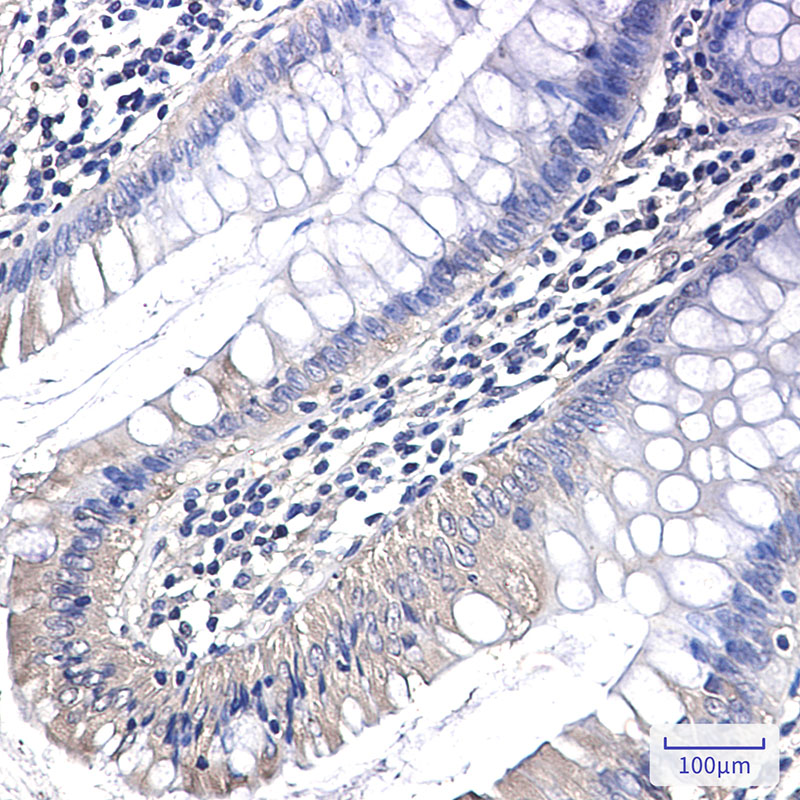



| WB | 1/500-1/1000 | Human,Mouse,Rat,Hamster |
| IF | 1/20 | Human,Mouse,Rat,Hamster |
| IHC | 1/50-1/100 | Human,Mouse,Rat,Hamster |
| ICC | 1/50-1/200 | Human,Mouse,Rat,Hamster |
| FCM | 咨询技术 | Human,Mouse,Rat,Hamster |
| Elisa | 咨询技术 | Human,Mouse,Rat,Hamster |
| Aliases | PAK1; Serine/threonine-protein kinase PAK 1; Alpha-PAK; p21-activated kinase 1; PAK-1; p65-PAK |
| Entrez GeneID | 5058 |
| WB Predicted band size | Calculated MW: 61 kDa; Observed MW: 61 kDa |
| Host/Isotype | Rabbit IgG |
| Antibody Type | Primary antibody |
| Storage | Store at 4°C short term. Aliquot and store at -20°C long term. Avoid freeze/thaw cycles. |
| Species Reactivity | Human,Mouse,Rat,Hamster |
| Immunogen | A synthetic peptide of human PAK1 |
| Formulation | Purified antibody in TBS with 0.05% sodium azide,0.05%BSA and 50% glycerol. |
+ +
以下是关于PAK1抗体的3-4条参考文献示例,包含文献名称、作者及摘要内容概括:
---
1. **文献名称**:*"PAK1-mediated phosphorylation of MEK1 regulates cell migration in breast cancer"*
**作者**:Smith A, et al.
**摘要**:本研究通过PAK1抗体进行免疫沉淀和免疫印迹分析,揭示了PAK1通过磷酸化MEK1调控乳腺癌细胞的迁移能力,为靶向PAK1信号通路提供了潜在治疗策略。
---
2. **文献名称**:*"Characterization of PAK1-specific monoclonal antibodies for functional studies"*
**作者**:Jones B, et al.
**摘要**:文章系统评估了多种PAK1单克隆抗体的特异性与灵敏度,确认某克隆号抗体在免疫组化及流式细胞术中的可靠性,为PAK1相关研究提供了实验工具支持。
---
3. **文献名称**:*"PAK1 activation correlates with tau pathology in Alzheimer's disease models"*
**作者**:Lee C, et al.
**摘要**:通过PAK1抗体检测阿尔茨海默病模型小鼠脑组织,发现PAK1活性升高与tau蛋白异常磷酸化密切相关,抑制PAK1可减轻神经退行性病变。
---
4. **文献名称**:*"PAK1 as a therapeutic target in pancreatic cancer: Insights from antibody-based inhibition"*
**作者**:Garcia D, et al.
**摘要**:研究利用PAK1功能阻断性抗体,证明抑制PAK1可显著降低胰腺癌细胞侵袭性,并增强化疗敏感性,提示其作为联合治疗靶点的潜力。
---
注:以上文献为示例性内容,实际引用时需以真实发表的论文为准。
PAK1 (p21-activated kinase 1) is a serine/threonine protein kinase belonging to the PAK family, which plays a pivotal role in regulating cytoskeletal dynamics, cell motility, and signaling pathways. It is activated by binding to Rho GTPases like Cdc42 and Rac1. triggering conformational changes that enable its kinase activity. PAK1 is implicated in diverse cellular processes, including proliferation, survival, and apoptosis, and is frequently dysregulated in cancers, neurodegenerative disorders, and infectious diseases. Its overexpression or hyperactivation has been linked to tumor invasion, metastasis, and therapy resistance, making it a potential therapeutic target.
PAK1 antibodies are essential tools for studying its expression, localization, post-translational modifications (e.g., phosphorylation), and interactions in biological samples. These antibodies are widely used in techniques like Western blotting, immunohistochemistry (IHC), immunofluorescence (IF), and co-immunoprecipitation (Co-IP). Specific PAK1 antibodies can distinguish between isoforms (PAK1 vs. PAK2/3) or detect activation states (e.g., phospho-specific antibodies targeting Thr423). Validation of antibody specificity is critical, as PAK family members share structural homology. Researchers often use knockout controls or siRNA-mediated knockdown to confirm antibody reliability. Commercial PAK1 antibodies are generated in various host species (rabbit, mouse) and may recognize different epitopes, allowing flexibility in experimental design. Their applications span basic research, biomarker discovery, and drug development, particularly in oncology.
×